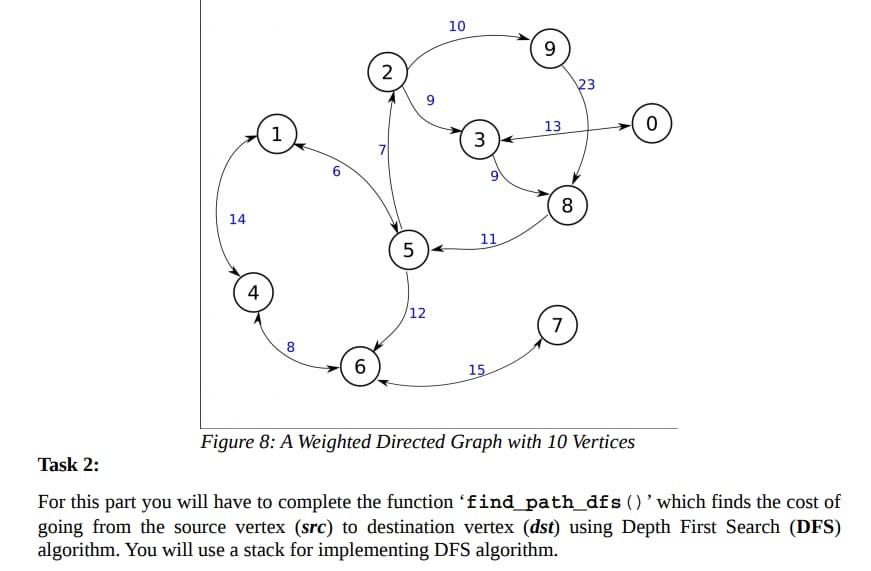Question
SKELETON CODE IS PROVIDED ALONG WITH C AND H FILES. #include #include #include #include #include node.h #include stack_functions.h #define NUM_VERTICES 10 /** This function takes

SKELETON CODE IS PROVIDED ALONG WITH C AND H FILES.
#include
#include
#include
#include
#include "node.h"
#include "stack_functions.h"
#define NUM_VERTICES 10
/** This function takes a pointer to the
adjacency matrix of a Graph and the
size of this matrix as arguments and
prints the matrix
*/
void print_graph(int * graph, int size);
/** This function takes a pointer to the
adjacency matrix of a Graph, the size
of this matrix, the source and dest
node numbers along with the weight or
cost of the edge and fills the adjacency
matrix accordingly.
*/
void add_edge(int * graph, int size, int src, int dst, int cost);
/** This function takes a pointer to the adjacency matrix of
a graph, the size of this matrix, source and destination
vertex numbers as inputs and prints out the path from the
source vertex to the destination vertex. It also prints
the total cost of this path.
*/
void find_path_dfs(int * graph, int size, int src, int dst);
int main()
{
int my_graph[NUM_VERTICES][NUM_VERTICES]; /// An adjacency matrix representation of graph
memset(my_graph,-1,NUM_VERTICES * NUM_VERTICES * sizeof(int)); /// Initiallize with -1 representing infinte cost.
for(int i=0; i add_edge(&my_graph[0][0], NUM_VERTICES, i, i, 0); /// All the vertices have a cost of 0 for visiting themselves add_edge(&my_graph[0][0], NUM_VERTICES, 0, 3, 13); add_edge(&my_graph[0][0], NUM_VERTICES, 1, 4, 14); add_edge(&my_graph[0][0], NUM_VERTICES, 0, 3, 13); add_edge(&my_graph[0][0], NUM_VERTICES, 1, 4, 14); add_edge(&my_graph[0][0], NUM_VERTICES, 1, 5, 6); add_edge(&my_graph[0][0], NUM_VERTICES, 2, 3, 9); add_edge(&my_graph[0][0], NUM_VERTICES, 2, 9, 10); add_edge(&my_graph[0][0], NUM_VERTICES, 3, 0, 13); add_edge(&my_graph[0][0], NUM_VERTICES, 3, 8, 9); add_edge(&my_graph[0][0], NUM_VERTICES, 4, 1, 14); add_edge(&my_graph[0][0], NUM_VERTICES, 4, 6, 8); add_edge(&my_graph[0][0], NUM_VERTICES, 5, 1, 6); add_edge(&my_graph[0][0], NUM_VERTICES, 5, 2, 7); add_edge(&my_graph[0][0], NUM_VERTICES, 5, 6, 12); add_edge(&my_graph[0][0], NUM_VERTICES, 6, 4, 8); add_edge(&my_graph[0][0], NUM_VERTICES, 6, 7, 15); add_edge(&my_graph[0][0], NUM_VERTICES, 7, 6, 15); add_edge(&my_graph[0][0], NUM_VERTICES, 8, 5, 11); add_edge(&my_graph[0][0], NUM_VERTICES, 9, 8, 23); /* Task 1: Complete the rest of the Adjacency Matrix according to Figure 8 */ print_graph(&my_graph[0][0], NUM_VERTICES); find_path_dfs(&my_graph[0][0], NUM_VERTICES, 4, 8); //find_path_dfs(&my_graph[0][0], NUM_VERTICES, 9, 2); getchar(); return 0; } void add_edge(int * graph, int size, int src, int dst, int cost) { *(graph+(src*size+dst)) = cost; /// Look carefully how the indices are calculated. You will need it for 2nd task. } void print_graph(int * graph, int size) { //char vertices[size]; for(int i=0; i { printf("\t%d", i); } printf(" "); for(int x=0; x { printf("%d\t", x); for(int y=0; y printf("%d\t", *(graph+(x*size+y))); printf(" "); } } void find_path_dfs(int * graph, int size, int src, int dst) { int visited[10] = {0}; /// To keep track of all the visited nodes /**** We make a stack for holding the visited vertices *******/ struct node * top = NULL; /// This is the top of the stack /** The DFS will work as follows: 1. Visit src vertex. Set 'current_visiting' to src. 2. Explore this vertex. If it is the destination vertex, stop. Otherwise visit its first unvisited neighbour (add to stack the current vertex) If no unvisited neighbour vertex remains, go back (pop from stack) 3. Repeat 2*/ int crnt_visiting = src; int crnt_exploring = src; int path_cost = 0; bool PATH_FOUND = false; while(!PATH_FOUND) { visited[crnt_visiting] = 1; /// Now we have visited this node struct element temp; if(crnt_visiting == dst) /// If the vertex is found { printf(" Path found: "); printf(" Cost: %d ", path_cost); while(!isStackEmpty(&top)) /// Empty the stack so all the allocated memory is freed. { printf("Pop "); pop(&top); } PATH_FOUND = true; continue; } else /// Explore this vertex { /** Complete this function. You are free to make any changes to this function. But make sure that path cost is correctly found. */ } } } STACK C FUNCTION #include #include #include #include "node.h" #include "stack_functions.h" struct element pop(struct node ** top) { struct element temp = (*top)->data; /// I copy the data at the top node into a temporary variable struct node * ptr_temp = (*top)->next; free(*top); *top = ptr_temp; return(temp); } void push(struct node ** top, struct element new_data) { struct node * new_node = (struct node *) malloc(sizeof(struct node)); new_node->data = new_data; /// I can assign one struct to another if the type is the same new_node->next = * top; * top = new_node; } bool isStackEmpty(struct node ** top) { return(*top == NULL); } STACK H FUNTION struct element pop(struct node ** top); void push(struct node ** top, struct element new_data); bool isStackEmpty(struct node ** top); NODE H struct element { int vertex_num; int cost_to_visit; }; struct node { struct element data; struct node * next; };
Step by Step Solution
There are 3 Steps involved in it
Step: 1

Get Instant Access to Expert-Tailored Solutions
See step-by-step solutions with expert insights and AI powered tools for academic success
Step: 2

Step: 3

Ace Your Homework with AI
Get the answers you need in no time with our AI-driven, step-by-step assistance
Get Started


